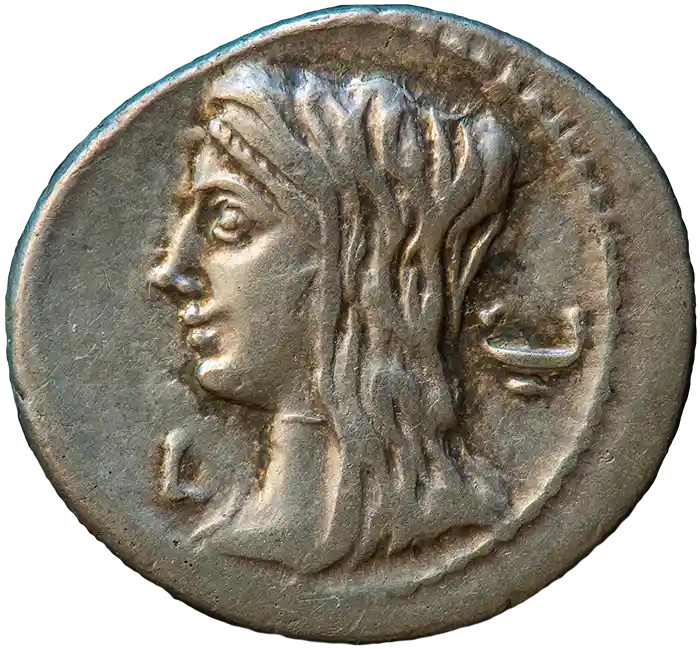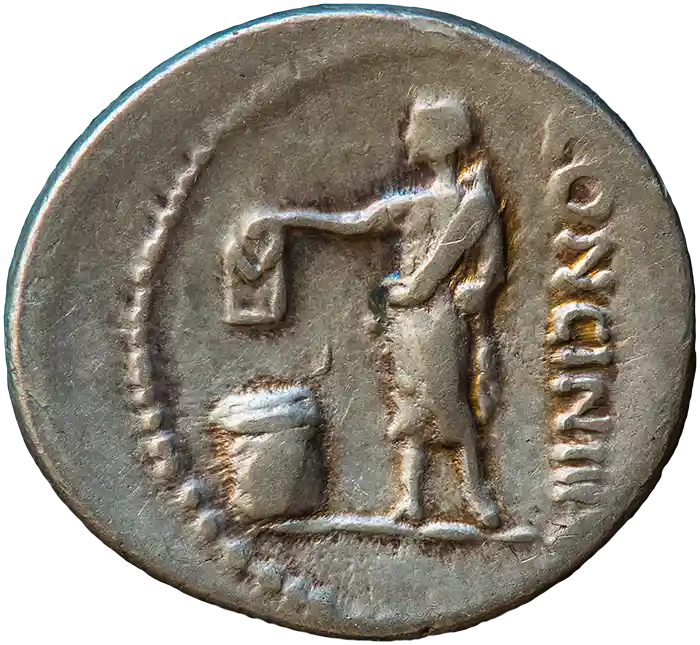Roman Republican
L. Cassius Longinus AR Denarius
- - - - - - - - - - - - - - - - - - - - - - -
CASSIUS, THE TRIAL AND THE LEX CASSIA TABELLARIA
Lucius Cassius Longinus was the brother of Gaius Cassius Longinus, one of the leading instigators in the assassination of Julius Caesar.
Quintus Cassius Longinus (from another coin in my collection) was his brother or cousin.
The moneyer's grandfather, Lucius Cassius Longinus Ravilla, was a respected judge who, in 113 BC, presided over the re-trial of two of the three Vestal Virgins who were accused of incestum (being unchaste).
Aemilia was found guilty and sentenced to death by the Pontifex Maximus
Lucius Caecilius Metellus Dalmaticus in the first trial of 114 BC.
Licinia and Marcia were both acquitted. Ravilla found them guilty in the re-trial and they were both sentenced to be executed by being buried alive.
Finally, given the seriousness of the events, the Romans performed numerous purification rites in the city, including the foundation of a new temple dedicated to Venus and the human sacrifice of two Gauls and two Greeks, considered ancestral enemies of Rome and therefore perfect for appeasing divine wrath, who were also buried alive in the Forum Boarium.
This was the last documented instance of human sacrifice in Rome
In fact, at the time many already saw the practice as barbaric and inhuman, and in 97 BC the Senate finally made them illegal.
This obverse marks 50 years since those events had unfolded, while the reverse notes how, as a tribune of the plebs in 137 BC, Ravilla had successfully proposed in the Concilium Plebis the lex Cassia tabellaria, which extended the secret ballot for trials in the popular assembly. This law provided that in most court cases tried by jury, jurors could mark their verdict on a small tablet and drop it into a basket to be counted by a court official. The exception was cases of treason, where a voice vote or show of hands was required. The practice also extended to voting on laws proposed in the Comitia Tributa and Concilium Plebis, the people's assemblies.
This reverse commemorates that proposal becoming law.
The V on the tablet stands for VTI ROGAS, "I approve" of the proposed law.
In fact, the vote could be expressed either with:
- Consent (V or VR for VTI ROGAS - as you propose / I approve)
- Abstention (N or NL for NON LIQVET - it is not clear / we do not vote)
- Dissent (A or AP for ANTIQVA PROBO - I approve the old discipline)
Once the vote was over, the votes were counted (diribitio)
and the result of the vote was communicated to the people (renuntiatio).
A COOL EASTER EGG
This coin is interesting because it doesn't show the coiner's personal and family names. However, on the obverse, below Vesta's chin, there is a control letter, and the only letters used in this issue are L, C, A, S, Ƨ, I.
Collecting all of them, one can write his name in full (L. CASSI).
But why would he do this? In the case of L. Cassius Longinus this decision appears to be connected to the Catiline conspiracy's recent exposure and repression. Not to be confused with our coiner, one of the most well-known cospirators was also named L. Cassius Longinus, hence his name being hidden!


